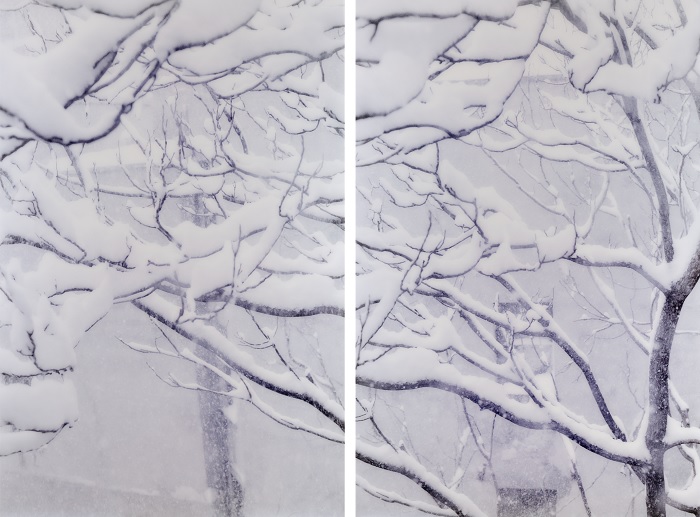
Seton Smith
American, 1955-
Snow Trees #2, 2006
chromogenic print face-mounted on Plexiglas, diptych, ed. 2/6
71 3/4 × 47 3/4 × 1 1/4 in. each
SBMA, Gift of Timothy A. Eaton
2018.19.2a,b

undated portrait
“My making things out of focus is saying that I am not trying to give a literal interpretation since we expect certain kinds of real information from photography. I want to make it obvious from the beginning that the viewer is invited into a psychological space.”
- Seton Smith
COMMENTS
Seton Smith's fame as an artist seemed like a foregone conclusion. Daughter of world-renowned sculptor Tony Smith, Seton and her sister Kiki grew up in their father's studio, helping him create geometric forms and small-scale models from an early age. The daughters would both have their first solo exhibitions in 1980, coincidentally, the year their father died.
While her sister has worked with a number of different media, Seton has continued to explore her unique method of photography. Using the Cibachrome method of printing, a process in which the color pigments are built into the paper rather than on the surface, Seton's fade resistant prints exhibit distinct colors with a glistening surface. She generally photographs everyday objects such as lamps, bowls and chairs, as well as specific elements in nature, like a solitary tree or bush. In 2000 Seton completed her first works in the medium of photogravure. These prints reflect her photography with their soft focus and flickering quality of light. Seton’s work is intentionally difficult to decipher upon first glance. For this reason, her images are open to wide range of interpretation as they draw upon the individual memory of each viewer.
http://www.marlboroughgallery.com/galleries/graphics/artists/seton-smith/graphics
Excerpt from “In Conversation: Seton Smith with Eve Aschheim”
Eve Aschheim (Rail): You’ve also made a lot of diptychs in which different kinds of relationships happen between the pairs. In some cases, the pairing of two slightly different foci implies the movement of a viewer, like frames in a movie, a disjunctive panorama. In “The Snow Trees” diptych, something I have never seen before happens. The two panels almost seem to form a continuous picture that simultaneously separates into two almost identical panels. What appears to be repetition is not. Perception is challenged.
Smith: Yes. I started working on that maybe in ’94 or so; they’re two versions of the same thing. I entitled the series “Deux Aspects.” It is about how there are many different perspectives from which to see the same story and how that changes as you move through space, which also relates to mirrors.
Rail: The snow trees are very flat—there’s a sheerness, like a slicing through the picture plane, and, at the same time, they are very sensual and there’s a beautiful rhythm. They have the kind of suddenness that I see in Japanese prints, or Chinese paintings, things pressed against the surface, confrontational. This gestural line or network, fluid but broken, as the snow breaks the continuity of the branches into line fragments while it presses the branches into a plane; frozen in ecstatic limbo. Each panel vacillating between autonomy and submersion into a larger picture that almost forms.
Smith: In the installation of the four diptychs comprising “Snow Trees”, I want it to be like a surround-sound of the snow-covered branches, a sort of flattened panorama. I think you are also talking about orientation in space, and how you are feeling in relation to a space. A main theme of my work is to ask people to look at how their environment—whether built or natural—is effecting them, because architecture seems so overpowering, in a literal sense. The photographs invite people to be more aware of their surroundings, what it’s telling us and where we place ourselves within it, psychologically and emotionally.
https://brooklynrail.org/2008/02/art/seton-smith-with-eve-aschheim
SBMA CURATORIAL LABELS
The daughter of renowned sculptor Tony Smith, Seton Smith grew up assisting her father in his studio alongside her sister Kiki Smith, also a successful artist. Despite the importance of sculpture in her family, photographs form the bulk of Seton Smith’s output. After studying painting at Boston University, the Museum School, and the Massachusetts College of Art, she moved to Paris in the mid-1970s, where she grew increasingly committed to the photographic medium. Smith specializes in monumentally-scaled Cibachrome diptychs like Snow Trees #2, which entices viewers to enter its natural realm while simultaneously barring them from doing so. Her choice to present the same wintry scene from two slightly distinct vantage points is borne of a desire to undermine the stable and singular reality typically associated with photography. Instead, she hopes to create a space of psychological resonance, memory, and fantasy, and to compel her audiences to consider how transitory movements through one’s environment can produce powerfully subjective sensations and emotions.
- A Brilliant Spectrum, 2019
